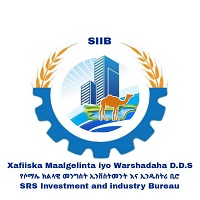Mineral resources
Various exploration works conducted in the past revealed the existence of various major and minor mineral occurrences in the Somali Region. The major mineral occurrences and deposits identified in the region include salt, gold, feldspar, mica and natural gas. There are also minor occurrences such as graphite, kaolin, magnetite, talc, phosphoric and gemstone.
Major salt occurrences are identified in three localities of the region, viz. Afder, Boji-dol and El-dere. Minor occurrences are also reported at Dolo-Odo, Melka-Softu, Sede and Kenere localities in Liben and Afder zones. Most of the occurrences are in brine form.
The geological favourability for primary gold deposit coupled with eluvial, deluvial and alluvial placer gold mining by local inhabitants attracted the attention of many geologists to the Moyale area. Apart from the potential resources of primary gold in Moyale area, there is a potential of places gold along the banks and steam beds on the eastern side of Moyale within a radius of 15-50 km. between Haramsam and Dukisso localities.
The major feldspar occurrences in the Somali Region are known at Shebelle area, near Bombas and Babile towns. The shebelle pegmatite lenses are a good quality quartz-orthoclase type which are suitable for high quality glass and bottle manufacturing. Mica occurrences are known at Shebelle and caravan areas. Investigation conducted in these localities revealed that the mica is poor in quality and low ingrade. However, it can be utilized in paper industry as mica powder.
The Somali National Regional State is the greatest oil and gas reserve area in Ethiopia owing to the existence of the required rock source for oil and gas prospectively and large sedimentary basin called the Ogaden Basin. The Calub Gas Share Company has been established to utilize the Calub Gas for fertilizer (Urea & NH3 ), electrical generation and production of petroleum products and other chemicals. The Calub Gas reserve is estimated at about 271 TCF or 76 Bm3.
The Somali Region is also endowed with other several mineral occurrences which could be utilized for various industrial applications. This includes graphite, kaolin, talc, phosphate etc. which are hosted within the meta - sedimentary sequence of upper protozoic age.
There are also wide occurrence of raw materials for construction in the Somali Region particularly in Korahe, Liben and Shinile Zones. The association of different geological formations with various geological environments in the region indicates the existence of other potential areas for construction raw materials.
Energy resources
The Somali Region is endowed with various energy, resources such as natural gas, hydropower, solar, wind and biomass resources.
Petroleum exploration activities in the Ogaden basin were carried out by a number of international companies during the last 38 years and it is found to be prospective for petroleum. Among the exploratory and development wells drived, the Calub area is ready for development to produce the gas condensate.
The major basins in Somali Region such as the Ogaden depression and the Wabi Shebelle River basins have tremendous potential for hydropower generation. The estimated dependable potential of these basins is 6974 GWH/Y which is roughly about 3.47% of the country’s potential. It is estimated that some 738 MW could be generated by harnessing the Wabi Shebelle River. Wind energy can be one of the main energy sources in the Somali Region. Although most of the zones in the region have high wind energy, there is no energy source that depends on wind speed in the Somali Region.
The Somali Region has also abundant solar energy potential. The solar radiation potential in the region is estimated to be 5500 to 6000 wh/m2. Hence the introduction and application of solar photo-voltaic (PV) technology can play vital role to meet the energy requirement in the area.
Biomass is the major energy source currently used in the region for cooking and other purposes. Since most of the population in the region have no experience in the use of agri-residues and dung as energy sources, they mostly depend on woody biomass energy.
Water Resources
The Somali Region can be divided into four basins. These are the eastern Ogaden, Wabi Shebelle, Genale-Dawa and part of the Awash basins. Wabi Shebelle, Weib, Genale, Dawa, Fafen and Gerer are the main rivers that form the main drainage systems of the region.
Wabi Shebelle is the largest basin with a total area of 205,400 km2 within Ethiopia. Jigjiga, Deghabour, Kebridehar, Kelafo are among the main towns that lie in the basin. The eastern Ogaden basin has a total area of about 71,900 km2 while the eastern part of the Awash basin has a catchment area of 47,360 km2 lying mostly in arid and semi-arid zones. Genale-Dawa is the largest basin after Abay and Wabi-shebelle occupying 168,000 km2. Main towns located in this river basin are Moyale, Wachile, Filtu etc.
